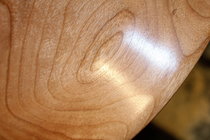I made a batch today with a recipe consisting of 8 oz beeswax, 8 oz diatomaceous earth and 32 oz of mineral oil. Works pretty good so far though doesn't seem as gritty as the store bought I've been using.
Tomorrow I'm going to make a smaller batch without the grit, just beeswax and mineral oil for a polish then I was wondering if I could add some carnauba wax to that mix or will it hurt the beeswax somehow because of the different melting points?
Also, not knowing when to leave well enough alone I was wondering what will happen if I add some of the colored mica powder that is used for epoxy? Could you make an embellishing wax with that to make open grain woods stand out more? Or would it stain the wood or just disappear when you buff it?
I have some store bought embellishing wax that works pretty well but it smells like it has a solvent in it. Skip the mineral oil and use turpentine? Read about me in the paper next day? MAN and BOXER DOG killed in kitchen explosion!
So, thoughts? Could buy all this but what's the fun in that? (plus I'm cheap) No wait.... FRUGAL.
Tomorrow I'm going to make a smaller batch without the grit, just beeswax and mineral oil for a polish then I was wondering if I could add some carnauba wax to that mix or will it hurt the beeswax somehow because of the different melting points?
Also, not knowing when to leave well enough alone I was wondering what will happen if I add some of the colored mica powder that is used for epoxy? Could you make an embellishing wax with that to make open grain woods stand out more? Or would it stain the wood or just disappear when you buff it?
I have some store bought embellishing wax that works pretty well but it smells like it has a solvent in it. Skip the mineral oil and use turpentine? Read about me in the paper next day? MAN and BOXER DOG killed in kitchen explosion!
So, thoughts? Could buy all this but what's the fun in that? (plus I'm cheap) No wait.... FRUGAL.

